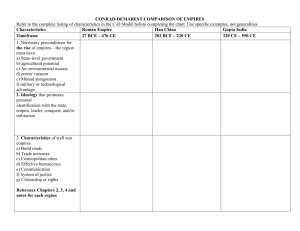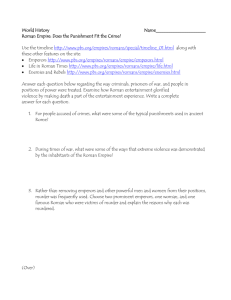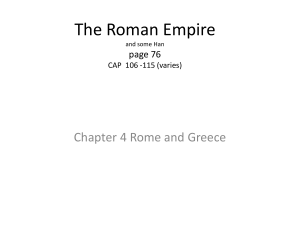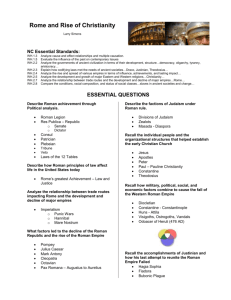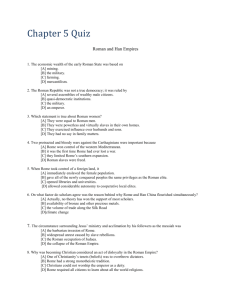Essay 1
advertisement
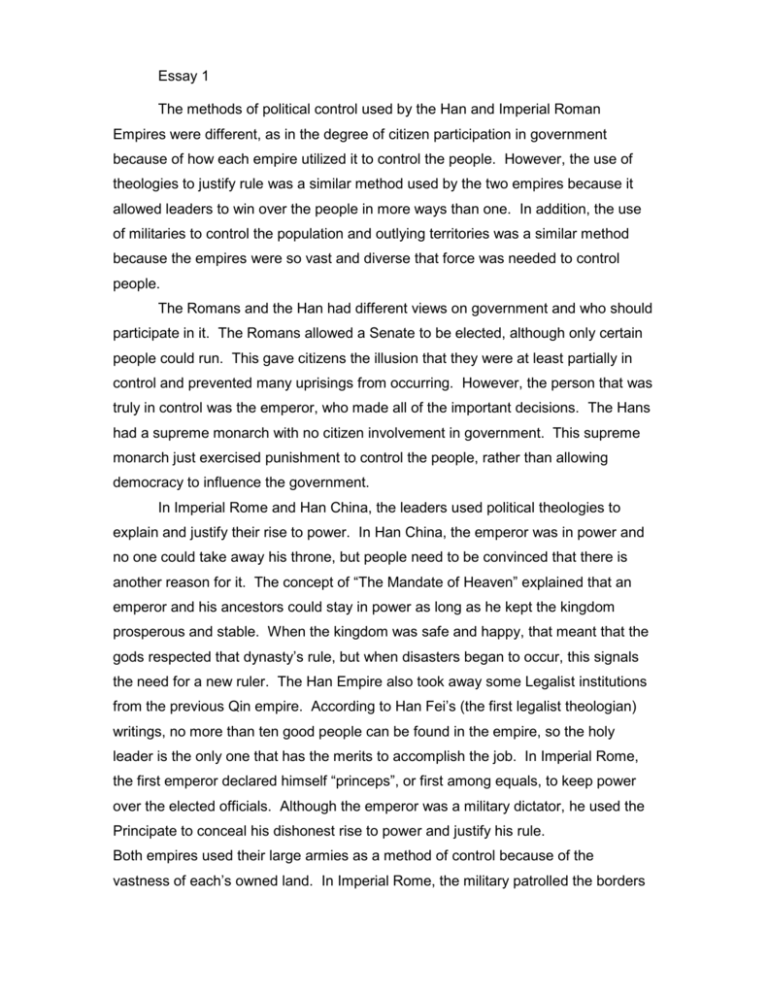
Essay 1 The methods of political control used by the Han and Imperial Roman Empires were different, as in the degree of citizen participation in government because of how each empire utilized it to control the people. However, the use of theologies to justify rule was a similar method used by the two empires because it allowed leaders to win over the people in more ways than one. In addition, the use of militaries to control the population and outlying territories was a similar method because the empires were so vast and diverse that force was needed to control people. The Romans and the Han had different views on government and who should participate in it. The Romans allowed a Senate to be elected, although only certain people could run. This gave citizens the illusion that they were at least partially in control and prevented many uprisings from occurring. However, the person that was truly in control was the emperor, who made all of the important decisions. The Hans had a supreme monarch with no citizen involvement in government. This supreme monarch just exercised punishment to control the people, rather than allowing democracy to influence the government. In Imperial Rome and Han China, the leaders used political theologies to explain and justify their rise to power. In Han China, the emperor was in power and no one could take away his throne, but people need to be convinced that there is another reason for it. The concept of “The Mandate of Heaven” explained that an emperor and his ancestors could stay in power as long as he kept the kingdom prosperous and stable. When the kingdom was safe and happy, that meant that the gods respected that dynasty’s rule, but when disasters began to occur, this signals the need for a new ruler. The Han Empire also took away some Legalist institutions from the previous Qin empire. According to Han Fei’s (the first legalist theologian) writings, no more than ten good people can be found in the empire, so the holy leader is the only one that has the merits to accomplish the job. In Imperial Rome, the first emperor declared himself “princeps”, or first among equals, to keep power over the elected officials. Although the emperor was a military dictator, he used the Principate to conceal his dishonest rise to power and justify his rule. Both empires used their large armies as a method of control because of the vastness of each’s owned land. In Imperial Rome, the military patrolled the borders and major roads of the empire, maintaining the “pax romana” or Roman peace. This allowed commerce to flourish throughout the region. In Han China, men were required to serve in the military for at least two years for border protection, fort building and keeping tabs on barbaric neighbors. The armies of both empires served as a sign of power to both enemies and citizens. This prevented invasions and breaking of laws. Also, the armies were used to take over other regions and gain political control over them. In addition, though the government of each empire were very strict, they couldn’t be everywhere at once, and the armies provided the political presence that was needed. Essay 2 The methods of political control in Imperial Rome and Classical India were more similar because they both emphasized a single ruler or emperor because each area was quite vast and fragmented, thus needing unification. They also had a similar form of provincial administration due to the fact that the emperor’s power would decrease in the far reaches of the empire. However, they had different methods of religious control for they had dissimilar view on religion as a way to control the people. Both empires had a single emperor because of the inherent need for unity. Both areas were politically fragmented before each empire arose. In the early Mediterranean, there was constant conflict and political tension between city-states. The Roman Empire came along and stopped the fighting because they were all under one ruler. Having the entire Mediterranean Sea under one emperor instilled the “pax romana”, which was the peace of trade inside the Roman empire. In India, seperate smaller monarchies would constantly battle until unified under the Mauryan Empire. But, after the Mauryans fell, India became fragmented again, thus reemphasizing the need for an emperor. In both places, they fought and bickered in and amongst themselves until the ruler came around to unify them. The single ruler figured as a method of political control in both empires because the emperor made most of the decisions about the law, about taxation, and various other political aspects of the region. In other words, this one strong political figure ran the country mostly on his own. Both empires had similar provincial administration due to the vast territory of both empires. News from Rome or Pataliputra would take at least days. Each empire had far reaching territories such as Egypt and Cappadocia in Rome, and Punjab and Bengal in Gupta, could me up to 1,000 miles away from the capital. The began to use this provincial administration to keep this under control because of the slow time it would take to ride 1,000 miles out to Cappadocia to deliver news from the emperor. Also, in both empires high-ranking officials or friends of the emperor would serve as a sort of “governor”. They would be a mini-emperor for a specific region of the empire and report to the ruler what he needed. Different, though, was the control of religion in the two empires, because they had different views on religion as a tool used to control the people. In Rome, the emperor was worshipped as a deity, so people who didn’t follow the traditional Roman polytheism couldn’t worship him. He used the common religion to gain political power and control over the people. Christians were the main focus of religious persecution in Imperial Rome. They were monotheistic, so their inability to worship the emperor as a god threatened his power. They even imprisoned, condemned and executed Jesus, who was part of the basis for Chirstianity.The Gupta, however, were not so focused on religion in politics. They kept the two separate. True, Ashoka was an avid Buddhist and posted edicts in rock around the empire to facilitate a Buddhist lifestyle, but he did not persecute those who did not live as a Buddhist. His influence to the religious lifestyle was more subtle than the Romans. Instead of the government sponsoring persecution of those who did not follow in his footsteps, Ashoka wanted them to follow his path to help unify under a religion, but he did not attack those who did not. In Imperial Rome, religion played a more key role in politics than in Mauryan and Gupta India. Essay 3 The methods of political control in Imperial Rome and Classical India were more similar because they both emphasized a single ruler or emperor because each area was quite vast and fragmented, thus needing unification. They also had a similar form of provincial administration due to the fact that the emperor’s power would decrease in the far reaches of the empire. However, they had different methods of religious control for they had dissimilar view on religion as a way to control the people. Both empires had a single emperor because of the inherent need for unity. Both areas were politically fragmented before each empire arose. In the early Mediterranean, there was constant conflict and political tension between city-states. The Roman Empire came along and stopped the fighting because they were all under one ruler. Having the entire Mediterranean Sea under one emperor instilled the “pax romana”, which was the peace of trade inside the Roman empire. In India, seperate smaller monarchies would constantly battle until unified under the Mauryan Empire. But, after the Mauryans fell, India became fragmented again, thus reemphasizing the need for an emperor. In both places, they fought and bickered in and amongst themselves until the ruler came around to unify them. The single ruler figured as a method of political control in both empires because the emperor made most of the decisions about the law, about taxation, and various other political aspects of the region. In other words, this one strong political figure ran the country mostly on his own. Both empires had similar provincial administration due to the vast territory of both empires. News from Rome or Pataliputra would take at least days. Each empire had far reaching territories such as Egypt and Cappadocia in Rome, and Punjab and Bengal in Gupta, could me up to 1,000 miles away from the capital. The began to use this provincial administration to keep this under control because of the slow time it would take to ride 1,000 miles out to Cappadocia to deliver news from the emperor. Also, in both empires high-ranking officials or friends of the emperor would serve as a sort of “governor”. They would be a mini-emperor for a specific region of the empire and report to the ruler what he needed. Different, though, was the control of religion in the two empires, because they had different views on religion as a tool used to control the people. In Rome, the emperor was worshipped as a deity, so people who didn’t follow the traditional Roman polytheism couldn’t worship him. He used the common religion to gain political power and control over the people. Christians were the main focus of religious persecution in Imperial Rome. They were monotheistic, so their inability to worship the emperor as a god threatened his power. They even imprisoned, condemned and executed Jesus, who was part of the basis for Chirstianity.The Gupta, however, were not so focused on religion in politics. They kept the two separate. True, Ashoka was an avid Buddhist and posted edicts in rock around the empire to facilitate a Buddhist lifestyle, but he did not persecute those who did not live as a Buddhist. His influence to the religious lifestyle was more subtle than the Romans. Instead of the government sponsoring persecution of those who did not follow in his footsteps, Ashoka wanted them to follow his path to help unify under a religion, but he did not attack those who did not. In Imperial Rome, religion played a more key role in politics than in Mauryan and Gupta India. Essay 4 The Han and Roman empires were different in their methods of political control in the classical period as they used the monarch and republic systems respectively because of the differences in societal organization. However, these empires were similar in that they were both ruled by autocratic rule at some point to strengthen the government’s political control. Ultimately, these empires were similar in that the leaders used religious and ideological influence to control the people because people trues ideologies and religions to guide their actions. A difference in the Roman and Han empires’ political control was their use of the republic system and monarchy. The monarchy of the Han empire was a method of political control because it strengthened the power of the government to crackdown on civilians and prevent protest. This method of control reflected the rigid system of beliefs that were popular in Han China. In the Roman empire, the republic method of political control kept a perceived balance of power and supposedly stable government, reducing the desire in citizens for protest and therefore keeping the power in the hands of the few. The effectiveness of the Republic system in Rome is demonstrated by the explosion of art, giving credence to the idea that the people felt content and empowered. This also represents the societal makeup of Rome as seemingly scholarly and the desire to look as though it cares for its citizens. These two methods of political control were very different but essentially created the stability of the empire. Both of these systems had one central figure that was eventually a dictator or monarch. This was a method of political control because of the ability and power of a single leader to quickly squash rebellion and dissent. In the case of Rome, Generals often had armies more loyal to a leader than to the state. This led to a constant struggle for power that nearly destroyed the empire. Octavius, a relative of Julius Caesar, officially established a military dictatorship that would last until the transition of the Roman empire to the Byzantine empire. In the Han dynasty, or the series of monarchs of the same extended family, monarchs had absolute control and there was much vying and contest between families to get the person on the throne that would do the most good for their family. Single leaders often used religion or ideologies as methods of political control as well. Various beliefs were used in the Roman and Han empires to control the people. For example, in rome, any religion that did not consider the ruler a divine deity was outlawed.This included the persecution of many Jews and Christians. This was because any disagreements between groups of people on religion may lead to civil war and destabilize the region. The polytheistic religions that encouraged people to believe that the Roman leaders were gods gave a huge amount of political control over the people. Ironically, Christianity also became a unifying factor under the reign of the Roman emperor Constantine. The fact that many of the people in the Roman empire were Christian gave Constantine immense political control as people looked to him as a religious ruler as well. Finally in the Han empire, Confucianism was a very large factor in every aspect of the empire. Everything from social classes to common courtesy was derived from this ideology. Addit ionally, the mandate of heaven that was instituted during the Zhou dynasty gave the leaders immense political control as the popular ideology of the time gave them the credibility to rule. Without any disagreement or dissent. The methods of political control of the Han and Roman empires were very similar. In fact, it is stunning how two civilizations with little contact could be so similar. These same similarities are found through much of the ancient world, and can even be found today.
